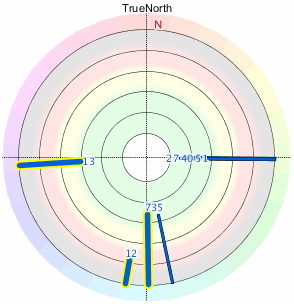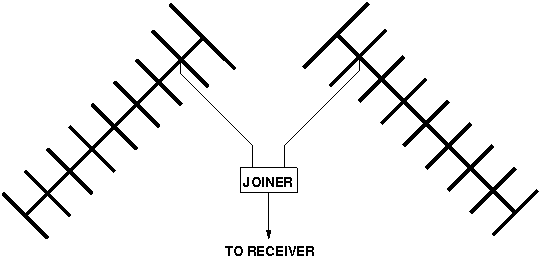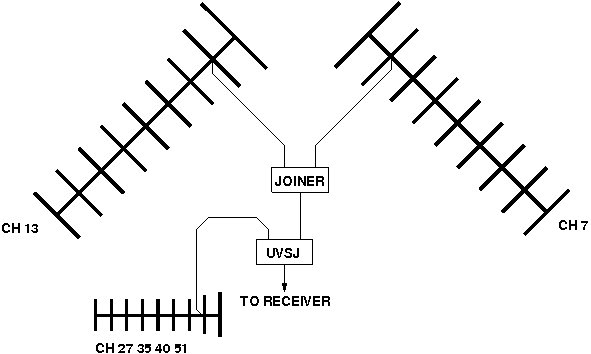Creating a usable over the air (OTA) TV antenna system is one of those things that usually involves a significant amount of experimentation ... but you have to start somewhere.
A good place to start is with the worst signal you want to receive. Here is the important bit from my TV Fool report (as discussed in a previous post):

The farthest transmitter in our list of desired channels (7 13 27 35 40 51) is channel 13 at 41km (25.2 miles). Applying a realism filter to the claims of the people that make TV antennas, we come up with a requirement for some sort of medium gain antenna. How about we specify an antenna that does both our bands of interest and just point it at the channel 13 transmitter? This, by the way, is all we have to do in most situations. Deal with the worst and hope for the rest.

We would then have the close 27 40 and 51 directly behind the transmitter. Good. Most antennas work reasonably well to the rear. We unfortunately have 7 and 35 that are not so close and they are pretty much at right angles to the antenna. Most antennas are quite good at rejecting signals to the side. The solution here is to rotate the antenna so it points between 13 and 7/35. Lower gain antennas are better at receiving stations over a wider angle so we might be better off downgrading to a low gain antenna ... an unhappy but common compromise.
If I was in a more rural environment I might be done. I am instead in what might be termed a high density suburban area. My neighbours all have cable and do not have to bother with interference caused by their electronics. I am not blameless with respect to interference either. Low gain antennas are also good at receiving noise over a wider angle. I used to use a single low gain antenna in the analog days and had to live with all the received noise.
We go on ...
Before we unleash the dogs of complexity we might want to think about our available assets. I just happen to have a couple of high gain recovered antennas that are optimized for channel 12 and were expected to work reasonably well on channel 7.
Channel 7 is on our list. So that just works. Channel 13 is only a few percent different from channel 12 in terms of radio frequency. It would have a lot of gain when used on channel 13. Unfortunately the 13 and 7 transmitters are are at right angles so a single high gain antenna is the last thing we want here.
We have two antennas available. I didn't pay anything for the antennas. Why not point each antenna directly at a transmitter?
In the analog days the answer to the proceeding questions would of been; ghosts otherwise known as reflections. The antenna pointing in the wrong direction for the desired channel would receive reflections quite well. Special filters were required to eliminate these reflections. Digital TV is very good at cancelling out these reflections (relevant post). As a result, multiple antennas can work quite well here in the 21st century.
You can combine the signals with a splitter/joiner:

If your antennas are pointing in more or less the same or opposite directions you should make the cables between the antennas and the joiner the same length. That is in the hope that the two signals will add together rather than cancel. In our right angle case it doesn't really matter. If you have matching transformers on one of both of the antennas you should reverse the antenna connections on one of them to see if things get better.
That takes care of channels 7 and 13 leaving 27, 35, 40, and 51. Here we finally get lucky. With 7 and 13 being in the VHF-hi band and 27-51 being in the UHF band we can use a band separator/joiner. In this case we want a UVSJ (UHF, VHF). The band separator/joiner will completely isolate the 7 and 13 antennas which allows us to consider the problem of receiving 27-51 with no consideration of what we have done so far. Channel 35 is the only remaining transmitter that is not right next door so we just use a low gain UHF band antenna with the hope that we can find a magic angle that will work for all 4 channels. This might work because the UHF band is at a higher frequency where there is less woman made noise.
We end up with this:

This was a very specific example. The point here is that this can be a reductionist process. That can make this a lot of fun for those that are into that type of thinking.
We now have a configuration we can build and try out...
posted at: 15:04 | path: /tv | permanent link to this entry